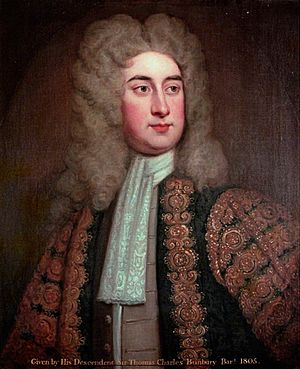4th Parliament of Great Britain facts for kids
Quick facts for kids 4th Parliament of Great Britain |
|||||
|---|---|---|---|---|---|
|
|||||

Sir Thomas Hanmer, Bt, Speaker of the House of Commons
|
|||||
| Overview | |||||
| Term | 12 November 1713 – 15 January 1715 | ||||
| House of Commons | |||||
| Members | 558 MPs | ||||
| Speaker of the House of Commons | Sir Thomas Hanmer | ||||
| House of Lords | |||||
| Lord Keeper of the Great Seal | Simon Harcourt | ||||
| Sessions | |||||
|
|||||
The 4th Parliament of Great Britain was an important meeting of lawmakers. It was called by Queen Anne on 18 August 1713. The Parliament officially started on 12 November 1713. However, it was put on hold until 16 February 1714. This Parliament was Queen Anne's last one. It ended on 15 January 1715.
Contents
Who Was in Parliament?
The new House of Commons had many members from the Tory party. They won a lot more seats than in the election before. There were 369 Tories who supported the government. The Whig party had 162 members, plus 13 who supported them. There were also 14 other members.
Sir Thomas Hanmer, who was a member for Suffolk, became the Speaker. The Speaker is like the leader of the House of Commons meetings.
Political Parties: Tories and Whigs
In Great Britain at this time, there were two main political groups. The Tories generally supported the King or Queen and the Church of England. The Whigs often wanted more power for Parliament and were sometimes more open to different religious views.
Key Leaders and Changes
Robert Harley, 1st Earl of Oxford and Earl Mortimer, was a very important government official. He was the Lord High Treasurer, which meant he managed the country's money. He was also a leader of the Tory party. However, he faced many challenges.
The Tory party itself was divided. Some Tories supported the Jacobites, who wanted the old royal family (the Stuarts) back on the throne. Others were "Hanoverians," who supported the new royal family, the Hanovers. Harley also had disagreements with Henry St John, 1st Viscount Bolingbroke, another powerful Tory leader.
For various reasons, Robert Harley lost his important job on 30 July 1714. He was replaced by Charles Talbot, 1st Duke of Shrewsbury. Shrewsbury was a "Hanoverian." Queen Anne was very ill at this time and passed away the very next day.
After Queen Anne's Death
After Queen Anne died, a special group called a Commission of Regency took charge. This group was mostly made up of "Hanoverian" supporters. They helped make sure that George, Elector of Hanover, became the new King. He was crowned King George I of Great Britain in October 1714.
Parliament met again for a short time to finish some important tasks. It was kept in place until January 1715. This was a safety measure in case the Jacobites tried to start a rebellion.
See also

